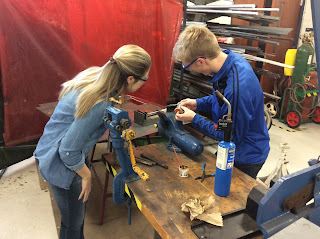Adding IBI to The Teacher Toolbox
As we continue on our teach Ag journey, we continually look to fill our teacher toolbox with instructional methods. This week were taking a further look at inquiry based instruction (IBI) and how to properly incorporate IBI into the classroom. Inquiry based instruction is a unique form of instruction allowing for a combination of student curiosity and the scientific method. This method teaching allows students to cultivate their own knowledge without formally being "spoon fed" the information. Students have the opportunity to gain a whole new level of learning by seeking answers, creating a deeper understanding for what is being learned.
"Teachers play a vital role in adapting the inquiry process to the knowledge and ability level of their students." This past week I had the opportunity to attend a workshop based around implementing agri-science with inquiry based instruction at the National FFA Convention. Through this workshop I was able to create a better understanding of how I will begin to develop myself as an educator using inquiry based instruction. Through developing lesson plans I will use the "Essential Features of Classroom Inquiry and Their Variations" chart. These chart includes the five features which must be present to be considered IBI.
1. Learner engages in scientifically oriented questions. This question will often come from the educator as a point of direction but can also also come from the students own curiosity.
2. Learner gives priority to evidence in responding to questions. Students will be given data to analyze or provide their evidence.
3. Learner formulate explanations from evidence. Explanations can be provided through pre-found evidence or formulate an explanation from their evidence.
4. Learner connects explanations to scientific knowledge. Connections can be provided to students or learners work to independently discover the links between information.
5. Learner communicates and justifies explanations. Students are given the steps to communicate findings or they will form logical arguments to communicate explanations.
There is a wide variety of options on how to properly implement IBI into the classroom. It is the teachers job to determine what the best way to help students cultivate their own learning. Inquiry based instruction needs to be unique to your students needs, however, there are many online resources available to help get started. Check out how Illinois Agriculture in the Classroom is implementing "implement me and I understand" into agricultural classrooms across the state.
_____________________________________________________________________________________________
Warner, A.J. & Myers, B.E. (2011) What inquiry-based instruction? Retrieved from https://edis.ifas.ufl.edu/pdffiles/WC/WC07500.pdf
Retrieved from https://edis.ifas.ufl.edu/pdffiles/WC/WC07500.pdf
"Teachers play a vital role in adapting the inquiry process to the knowledge and ability level of their students." This past week I had the opportunity to attend a workshop based around implementing agri-science with inquiry based instruction at the National FFA Convention. Through this workshop I was able to create a better understanding of how I will begin to develop myself as an educator using inquiry based instruction. Through developing lesson plans I will use the "Essential Features of Classroom Inquiry and Their Variations" chart. These chart includes the five features which must be present to be considered IBI.
1. Learner engages in scientifically oriented questions. This question will often come from the educator as a point of direction but can also also come from the students own curiosity.
2. Learner gives priority to evidence in responding to questions. Students will be given data to analyze or provide their evidence.
3. Learner formulate explanations from evidence. Explanations can be provided through pre-found evidence or formulate an explanation from their evidence.
4. Learner connects explanations to scientific knowledge. Connections can be provided to students or learners work to independently discover the links between information.
5. Learner communicates and justifies explanations. Students are given the steps to communicate findings or they will form logical arguments to communicate explanations.
There is a wide variety of options on how to properly implement IBI into the classroom. It is the teachers job to determine what the best way to help students cultivate their own learning. Inquiry based instruction needs to be unique to your students needs, however, there are many online resources available to help get started. Check out how Illinois Agriculture in the Classroom is implementing "implement me and I understand" into agricultural classrooms across the state.
_____________________________________________________________________________________________
Warner, A.J. & Myers, B.E. (2011) What inquiry-based instruction?
 Retrieved from https://edis.ifas.ufl.edu/pdffiles/WC/WC07500.pdf
Retrieved from https://edis.ifas.ufl.edu/pdffiles/WC/WC07500.pdf
Warner, A.J. & Myers, B.E. (2014). Implementing inquiry-based teaching methods. Retrieved from https://edis.ifas.ufl.edu/pdffiles/WC/WC07600.pdf
Retrieved from https://edis.ifas.ufl.edu/pdffiles/WC/WC07600.pdf
 Retrieved from https://edis.ifas.ufl.edu/pdffiles/WC/WC07600.pdf
Retrieved from https://edis.ifas.ufl.edu/pdffiles/WC/WC07600.pdf
Alberta Learning. (2004) Focus on inquiry: a teacher’s guide to implementing inquiry-based learning. Retrieved from https://education.alberta.ca/media/313361/focusoninquiry.pdf
Retrieved from https://education.alberta.ca/media/313361/focusoninquiry.pdf
 Retrieved from https://education.alberta.ca/media/313361/focusoninquiry.pdf
Retrieved from https://education.alberta.ca/media/313361/focusoninquiry.pdf
Thoron, A.C., Myers, B.E., & Abrams, K. (2011). Inquiry-based instruction: How is it utilized accepted, and assessed in schools with national agriscience teacher ambassadors? Journal of Agriculture Education, 52(1), 96-106. DOI: 10.5032/jae.2011.01096





Comments
Post a Comment